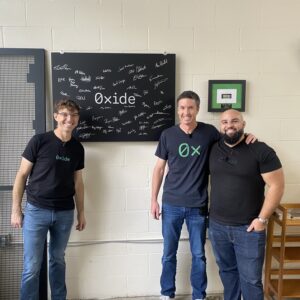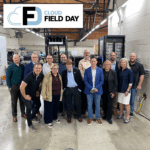|
|
 Matthew Sanabria, Steve Tuck, and Bryan Cantrill presented for Oxide at Cloud Field Day 24 |
This Presentation date is October 22, 2025 at 10:30-12:00.
Presenters: Bryan Cantrill, Matthew Sanabria, Steve Tuck
Scaling Up The Cloud Computer with Oxide Computer
Watch on YouTube
Watch on Vimeo
Cloud computing has been the most significant platform shift in computing history, allowing companies to modernize and grow their businesses. While cloud computing has accelerated businesses, it has begun to hit its limits. Companies need to extend their operations beyond the public cloud for reasons like locality, security, sovereignty, and regulatory compliance. However, operating infrastructure outside the public cloud often feels like a step back in time, relying on traditional rack-and-stack approaches with limited efficiency and utility.
Oxide Computer Company aims to address this by bringing true cloud computing on-premises. To achieve this, they’ve built a completely different type of computer, a rack-scale system designed holistically from the printed circuit board to the APIs. This approach delivers improvements in density, energy efficiency, and operability, all plumbed with software for operator automation. The goal is to provide businesses with elastic, on-premises scalable computing that mirrors the efficiencies enjoyed by hyperscalers.
The Oxide system features a modular sled design for easy component upgrades, DC power, and a comprehensive software stack, including firmware, an operating system, a hypervisor, and a cloud control plane. This design enables elastic services like compute, storage, and networking, with multi-tenancy and security built in. The company has seen a surge in demand, expanding manufacturing operations and targeting various verticals, including federal, financial services, life sciences, energy, and manufacturing. Oxide focuses on providing modern API-driven services, improved utilization, enhanced energy efficiency, and a trusted product to alleviate public cloud costs and enterprise software challenges.
Personnel: Steve Tuck
Who wants Oxide Computer and Why
Watch on YouTube
Watch on Vimeo
The video centers on Oxide’s mission to address the inefficiencies and integration challenges prevalent in the industry, which is commoditized and ossified. Oxide started with a clean sheet of paper, tackling problems accumulated over decades by building their own machines fit for purpose, rather than relying on personal computers in data centers. Oxide aims to disrupt the visceral problems in the industry, like AC power supplies per 1U/2U, cords everywhere, fans everywhere, inefficiency; that is just the beginning. Oxide sought not only to replicate what hyperscalers had done —such as using a DC bus bar design —but also to leapfrog them with new differentiators, like the cabled backplane, which removes cabling from the sleds. Another big bet the company made was removing the BIOS —the basic input/output system —originally from CPM.
Bryan Cantrill shared that the company has differentiated on several fronts, including power and efficiency, reliability, operability, and time to deployment, aiming for developers to be working within hours of the IT team uncrating the sleds. When Oxide’s board member, Pierre Lamont, asked Bryan Cantrill what Oxide’s differentiator was, Bryan responded that there is no single differentiator but many. This approach enables Oxide to serve multiple verticals and address distinct customer pain points. Oxide initially underestimated the demand from AI companies. They were surprised to find that the security of their system, particularly the true root of trust and attestation of the entire stack, was a major draw for these companies.
Addressing concerns about single vendor lock-in, Cantrill emphasized Oxide’s commitment to transparency through open-source software. The entire stack is opened up, including the service processor and associated software. The open-source approach, while not entirely mitigating single-vendor risk, provides customers with unprecedented visibility and control, fostering confidence and helping manage risk. Finally, acknowledging the barrier to entry for enterprises due to the rack-level integration, Oxide offers a trial program with a rack in a co-location facility, allowing potential customers to experience the benefits of Oxide’s system firsthand.
Personnel: Bryan Cantrill
Oxide Integrations: Empowering Platform Teams and Developers with Oxide Computer
Watch on YouTube
Watch on Vimeo
Matthew Sanabria from Oxide Computer Company discusses integrations that empower platform teams and developers to build on top of the Oxide platform. As Oxide is API-driven, these integrations are crucial for engineering teams needing to work at scale. Sanabria covers three platform integrations: a Go SDK, a Terraform provider, and a Packer plugin, demonstrating how each allows developers to interact with and manage resources on Oxide in a familiar way. The Go SDK offers programmatic access to the Oxide rack, while the Terraform provider enables state management for resources, and the Packer plugin allows the creation of custom images with baked-in application logic.
The presentation then shifts focus to Kubernetes integrations, which are vital for teams standardizing on Kubernetes. Oxide provides integrations for deploying and managing Kubernetes on its infrastructure, including a Cloud Controller Manager, a Rancher node driver, and an Omni infrastructure provider. The Cloud Controller Manager manages node health, load balancing, and routes, providing a Kubernetes-native integration. The Rancher node driver enables users to create Kubernetes clusters on Oxide via the Rancher UI, and the Omni infrastructure provider integrates with Talos Linux, an immutable Linux operating system designed for Kubernetes nodes.
Sanabria demonstrates these Kubernetes integrations in action, showing how the Cloud Controller Manager ensures node health and prevents cascading failures, how the Rancher node driver simplifies cluster creation, and how the Omni infrastructure provider automates the deployment of Talos Linux nodes on Oxide. These integrations provide flexibility for running Kubernetes on Oxide and allow future enhancements, such as load balancers and other controllers, to be seamlessly integrated with Kubernetes.
Personnel: Matthew Sanabria
Where are we going with Oxide Computer Integrations
Watch on YouTube
Watch on Vimeo
Matthew Sanabria focuses on future integrations for the Oxide Computer Company, aiming to expand its capabilities and make it a more attractive choice for customers. These integrations include a Kubernetes CSI plugin to enable Oxide storage with Kubernetes, the Kubernetes Cluster API to create clusters across different platforms using Kubernetes, and observability enhancements. The goal is to provide a comprehensive platform that integrates seamlessly with existing infrastructure and tools.
A key component of the future integrations is centered around observability. Oxide has developed a Grafana data source plugin that translates Oxide metrics for Grafana, eliminating the need for operators to use OXQL directly. Additionally, an OpenTelemetry receiver is being developed to convert Oxide metrics to the OpenTelemetry format, enabling users to send data to their preferred observability vendors, such as Datadog or Honeycomb. This effort aims to provide flexibility and compatibility with existing observability platforms.
The discussion expanded to potential use cases for Oxide in various verticals. Oxide aims to replace existing hypervisor infrastructure, offering a lower licensing cost option with its own hypervisor. For life sciences, research pipelines and data pre-formatting for supercomputers are key areas. Furthermore, Oxide emphasized that their platform provides traditional VMs capable of supporting any software, addressing concerns, and expanding possibilities of the types of applications and workloads that can be deployed on the Oxide platform.
Personnel: Matthew Sanabria









